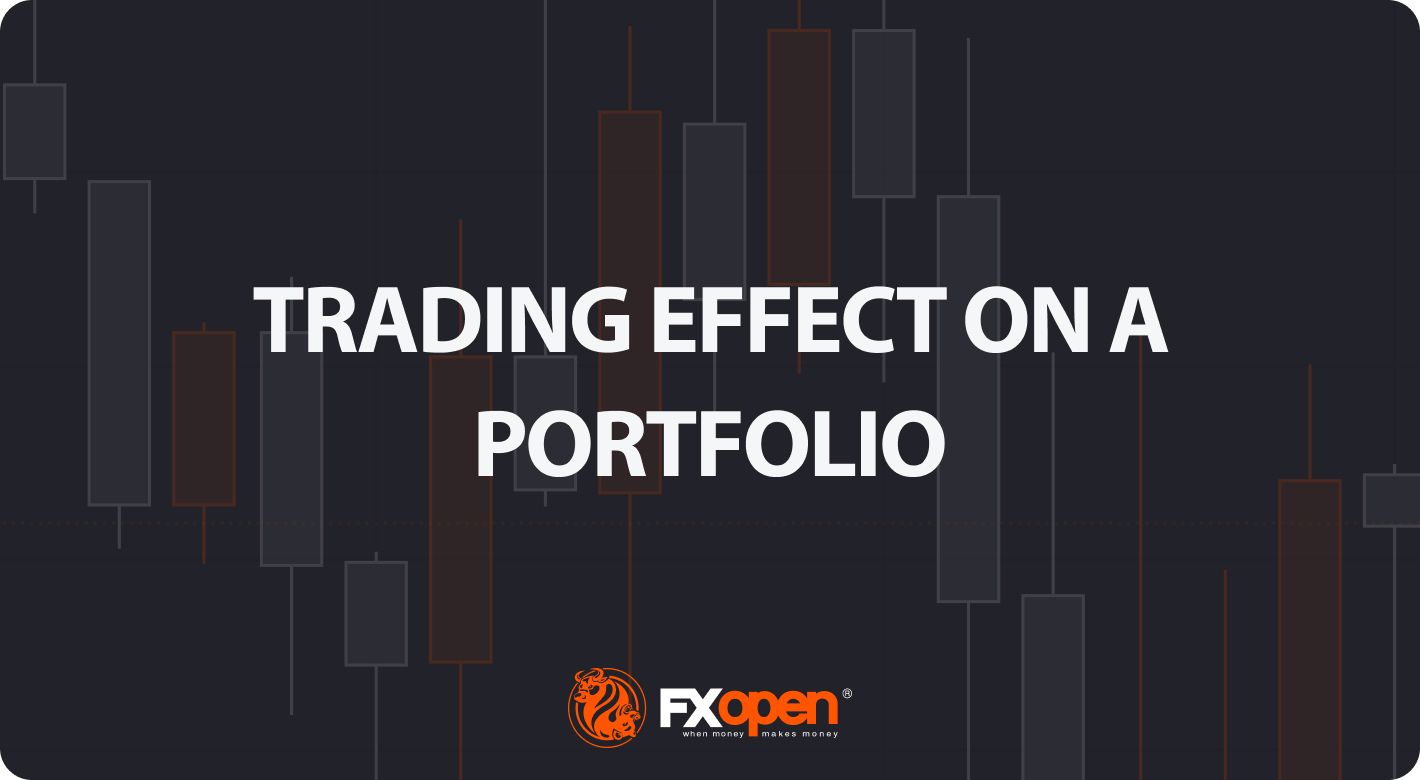FXOpen

When a person decides to join the financial world and buy stocks, commodities, currency, or perhaps even cryptocurrency*, they have to think about the approach they take to their management. There is the option of holding assets until they decide to sell them in months or years, and there is the option to trade them actively. Trading effect reflects how a trader’s actions influence the value of their portfolio.
This FXOpen article explains what the trading effect is and how it serves as a way to quantify a trader’s performance.
What Does Trading Effect Mean?
Trading decisions exert a substantial influence on the performance of a portfolio. What is an effect in stock, forex, commodity trading? The trading effect reflects the outcomes of the choices made by traders as they buy and sell financial assets. Whether one engages in short-term or long-term trading, the consequences of these decisions are palpable.
Short-term traders may experience rapid gains or losses, while long-term traders witness the cumulative effect of their actions over time. Managing trading strategies prudently is imperative to optimising portfolio performance.
Don’t confuse the trading effect with the trade effect, which encompasses the various impacts of trade on economies and industries. It involves the allocation of resources, changes in economic welfare, and the movement of capital and labour. This is not the effect we will focus on in this article.
Types of Effects
Effects can be categorised based on the type of asset or instrument being traded. There could be a stock, forex, commodities, or futures trading effect. The effects are not just positive and negative.
To analyse the impact of trading, traders apply various analytical tools and theories. The Epps effect in trading is one of them. It claims that the correlation between the returns of two different stocks decreases as the length of the interval for which the price changes are measured decreases. This effect is caused by asynchronous trading.
Short-Term vs Long-Term Trading Effects
Trading actions often yield immediate results, reflecting the rapid fluctuations and reactions within the market. The short-term trading effects can be driven by news events, earnings reports, market sentiment, and technical indicators that influence prices over short time frames. For instance, a day trader executing a quick buy or sell based on breaking news experiences immediate gains and losses.
In contrast, long-term trading strategies involve a more deliberate and sustained approach, shaping one’s financial future through careful portfolio management. Long-term trading effects manifest over an extended horizon, reflecting the cumulative impact of strategic decisions.
Risk and Reward in Trading
The risk-reward trade-off is a fundamental concept in trading that involves balancing the potential for profit against the likelihood of loss. Traders often assess the risks and rewards of a trade before executing it.
High-Risk Trading Strategies
High-risk trading strategies may lead to amplified trading effects. For example, using leverage allows traders to control a larger position with a smaller amount of capital. While this may amplify gains, it also magnifies potential losses and can result in margin calls, forcing traders to either inject more capital or close positions at unfavourable prices.
Trading highly volatile and speculative instruments can lead to significant price swings. While this volatility presents opportunities, it also introduces higher levels of risk. In unpredictable markets, sudden and unexpected price movements can also result in rapid losses, especially for traders employing aggressive strategies.
Strategies for Managing Risk
Diversifying across different asset classes and sectors helps spread risk. A well-diversified portfolio may be less susceptible to the negative impact of a single underperforming asset. Implementing stop-loss orders may limit potential losses. Traders determine these levels based on their risk tolerance and analysis of market conditions. They also control the size of each position relative to the total portfolio value, as it helps manage overall risk exposure.
Markets evolve, and different strategies may be more suitable in varying conditions. Traders adapt their approaches based on the prevailing market environment and establish realistic profit targets, ensuring that the potential returns justify the assumed risks.
The Impact of Behavioural Biases
Behavioural biases can significantly impact trading decisions, leading to unintended trading effects.
- Overtrading can lead to a cluttered portfolio and increased risk exposure. Driven by excessive confidence or impulsivity, it may erode gains through transaction costs.
- Loss aversion is a psychological and behavioural bias observed in humans, which refers to the tendency of people to strongly prefer avoiding losses over acquiring equivalent gains.
- Confirmation bias, favouring information that aligns with existing beliefs, can also lead to suboptimal decision-making. Confirmation bias potentially blinds traders to alternative perspectives and impacts their ability to adapt to changing market conditions.
Final Thoughts
Understanding and managing the trading effect is paramount for traders. Regular assessment and comparison of the results you get while trading over different time periods are foundational elements in developing the skills needed to navigate the market dynamics. If you want to continue building your portfolio, you may open an FXOpen account. Explore the TickTrader trading platform to choose between the various asset classes and diversify your portfolio properly.
*At FXOpen UK and FXOpen AU, Cryptocurrency CFDs are only available for trading by those clients categorised as Professional clients under FCA Rules and Professional clients under ASIC Rules, respectively. They are not available for trading by Retail clients.
This article represents the opinion of the Companies operating under the FXOpen brand only. It is not to be construed as an offer, solicitation, or recommendation with respect to products and services provided by the Companies operating under the FXOpen brand, nor is it to be considered financial advice.
Stay ahead of the market!
Subscribe now to our mailing list and receive the latest market news and insights delivered directly to your inbox.








